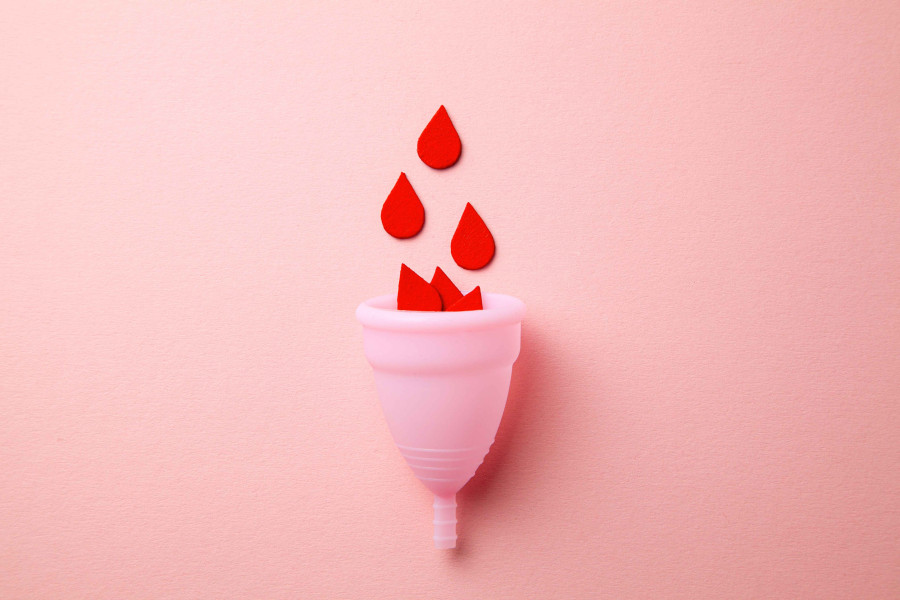National
Menstrual cups are gaining currency, albeit slowly
They are reusable after cleaning, and a sustainable option to pads and tampons. But opinion among Nepali women is divided over convenience.
Aakriti Ghimire
When Sukeerti Shrestha first heard of a menstrual cup, in 2018, she was fascinated. That one can wear a menstrual hygiene product that doesn’t leak for 12 hours and that it can ensure rashes-free periods was something exciting to Shrestha, a regular pad user.
She was game for it, she said. After she found a cup she could afford, there was no going back to sanitary pads.
“All I know is the pad days are over,” said Shrestha, 22.
Like Shrestha, there are many who share their excitement, comfort and ease with using menstrual cups. All those who use menstrual cups say that it is life-changing, and the best menstrual product available.
However, all menstrual cup users have had to overcome a lot of intimidation and various myths prior to switching to cups. According to menstrual health advocates, there is a lack of sufficient information on menstrual cups.
“We have been saying that menstrual cups are eco-friendly, easy and life-changing but if we look at the bigger picture, there are a lot of myths around it. It shows that there isn’t sufficient information on menstrual cups,” said Priyanka Budhathoki, co-founder of Period Kaa Kura, a Nepali podcast that debunks myths and taboos around menstruation. “One of the biggest myths around using it is the idea of virginity”
Many who haven’t had penetrative sex feared using a menstrual cup may cause them to “lose their virginity,” according to menstrual cup advocates. That fear keeps them from using cups, they say.
Shrestha, as a regular user of the menstrual cup today, said that as much as she was “mentally aware that virginity is a social construct,” it created a major barrier for her to use the cup in the initial days.
“There was a huge psychological factor. For about four-six months after buying, I didn’t even use it,” said Shrestha, a fourth-year BBA student at Kathmandu University School of Management.
Unlike conventionally used sanitary pads, menstrual cups are inserted into the vagina. These funnel-shaped and flexible cups collect the period fluid, unlike the pads or tampons that absorb it. Menstrual cups are usually made of silicone or latex rubber, and are eco-friendly period products. They are reusable and may last up to 10 years. They can be reused in every cycle, following a thorough sterilisation—simply by boiling for three to four minutes. By folding the cup, it is inserted through the vagina where it springs open and rests on the vagina walls. The tiny holes below the rim of the cup create suction and seal the cup in place, ensuring it doesn’t leak or fall off.
While many users were informed about the sustainability and long-term economic benefits of the cup, many who want to abandon the tedious pads and tampons have a plethora of concerns about it.
“We all talk about how sustainable a menstrual cup is, but what happens when it’s up there? Something is up in you for a while and I am going to be sitting on it for the entire day. What if the suction breaks?” said Bivechana Gautam, 23, donor relations executive at a multinational company, expressing her concerns about the cups. “That creeps me out, and that is why I don’t use it.”
In addition, menstrual health advocates also identified that until users are mentally ready and comfortable with exploring their genitalia, it will be difficult to transition from pads to cups.
“Even if you know the mechanics of using a menstrual cup, it is intimidating and it’s extremely easy to give up,” said Shreya Paudel, the co-founder of Embrace the Cycle, a social initiative on menstrual hygiene management. “That is because our vagina and vulva aren’t explored regions of our body.”
Many users also shared that they had tried the menstrual cups a couple of times before giving up on them, mostly because they couldn’t practically implement the techniques of using the cup, that they learnt scrolling through “million” Youtube videos.
“My menstrual cup is a decorative piece in my cupboard now,” said one, who bought her cup a year ago, tried using it and then gave up.
Providing accurate information and debunking myths, alongside a support system for menstrual cup users, are crucial to encouraging more women to use menstrual cups, according to experts.
Similar to the story of many other menstrual cup users, after months of not using the cup, Shrestha could use her menstrual cup only after overcoming her apprehension about it.
“Eventually, I started feeling extremely uncomfortable with pads,” said Shrestha.
Identifying that lack of information, Period Kaa Kura is releasing a new episode next Tuesday where they aim to explain the use of a menstrual cup in the Nepali language.
However, menstrual cups may not be the universal eco-friendly solution for all menstruators. The majority of trans men [transgender persons who have transitioned from female to male] are uncomfortable with using menstrual cups, while some are regular users.
“I had a panic attack when I tried to use a menstrual cup,” says Zion Magar, 21, a volunteer at Unity for Change, an organisation working mainly for trans men. “I am a trans man and I don’t want to insert anything. Of course, another trans friend of mine can easily use it, but many of us can’t.”
Likewise, menstruators with vaginismus or who have a history of abuse and trauma are unable to use cups, according to gynaecologists.
“For people with vaginismus, the moment you touch the genitalia, the muscle spasms and you can’t penetrate. Usually, there’s a history of trauma, child abuse or any bad experience associated with it,” said Anjana Karki, a gynaecologist at the B&B Hospital. “For these individuals, it is extremely difficult to use menstrual cups.”
Menstrual cup advocates are aware that menstrual cups are not the eco-friendly and easiest solution for every uterus owner. Every menstruator has a different shape and size of the uterus, and different lengths of their cervix which makes it difficult to find the perfect fit for a menstrual cup, they say.
But those who have been able to successfully use the cup, like Shrestha, say that it has changed the way they view their periods, making their menstruation days feel like any other day.
In the past couple of years, sellers of menstrual cups in Nepal say they have seen a sharp increase in sales and interest among customers.
“We started selling menstrual cups sometime around 2020. Initially, the demand was very little. We probably sold a thousand cups the first year. We had to focus a lot on education. But today, the sales have risen significantly – at least by four to five times,” says Rajat Sarawgi, CEO of Brand Bucket, the importer of PeeSafe menstrual cups.
“And now, we sell around ten thousand cups yearly. We have also begun getting calls from pharmacies who want to stock menstrual cups.”
Given the durability of menstrual cups, many regular users say it is a long-term investment they made for their own menstrual health. Not having bought pads thereafter, they said, they have saved up a lot of money as well.
A menstrual cup can be bought for around Rs500, which is equivalent to approximately sanitary pads worth two-three cycles.
Shrestha believes that more conversations and reliable information is extremely crucial.
“My source of information around menstrual cups were videos made by cup manufacturers who made it all sound really easy. But they failed to consider the fact that virginity as a concept made it extremely difficult for users like me to use,” said Shrestha.




 16.09°C Kathmandu
16.09°C Kathmandu










%20(1).jpg&w=300&height=200)




